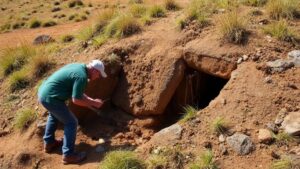Exploring Hidden Trails in National Parks for Historical Artifacts
Exploring Hidden Trails in National Parks for Historical Artifacts
National parks are often celebrated for their stunning natural beauty and diverse ecosystems, but they also serve as vital repositories of historical artifacts and cultural heritage. Hidden trails within these parks can lead to significant archaeological finds that provide insights into past human activity. This exploration can deepen our understanding of history, genealogy, and cultural practices while emphasizing the importance of preserving such treasures for future generations. This article will delve into various aspects of exploring hidden trails in national parks with a focus on historical artifacts.
The Importance of Historical Artifacts
Historical artifacts encompass a wide range of objects that reflect the lives, customs, and technologies of past civilizations. These can include tools, pottery, clothing, and even architectural remnants, which offer invaluable insights into the social and economic structures of their time. Understanding the significance of these artifacts is crucial as they help contextualize history within a geographical framework. For example, the discovery of ancient pottery along a trail in a national park might reveal trade routes used by indigenous tribes, echoing their interaction with surrounding communities.
Many hidden trails within national parks are not included in the mainstream hiking maps, making them ripe for exploration. These trails might have historical significance tied to indigenous groups or pioneer routes. Although these paths may seem less accessible, they often lead adventurers to significant archaeological sites. Resources such as historical maps, local archives, and consultations with park rangers can help hikers identify where these hidden trails may be located.
When searching for these trails, visitors might consider:
- Engaging with local historians or volunteer organizations focused on preserving local history.
- Exploring less trafficked areas, particularly in remote park sections.
- Utilizing topographic maps that may highlight historical features.
Case Studies of Successful Artifact Discoveries
Numerous case studies illustrate the successful discovery of historical artifacts through the exploration of hidden trails. One notable example is found in the Grand Canyon National Park, where archaeologists uncovered a series of ancient Ancestral Puebloan dwellings. Researchers exploring lesser-known trails stumbled upon these structures, which contained pottery and tools dating back over 1,500 years, revealing much about the lifestyle and culture of the early inhabitants.
Another significant discovery occurred in Yosemite National Park, where explorers along a hidden trail found remnants of a 19th-century miners camp. Artifacts recovered from this site included mining tools, discarded equipment, and personal items that told stories of the Gold Rush era and the impact it had on the region.
Challenges and Considerations
While exploring hidden trails can yield fascinating discoveries, it also presents various challenges. Firstly, these areas may be more difficult to navigate due to lack of marked paths and limited information. Also, potential environmental impacts must be considered; for instance, disturbances caused by foot traffic might damage delicate archaeological sites.
Regulations governing national parks often restrict the removal of historical artifacts. This means that explorers must be aware of legalities regarding artifact collection and should prioritize documenting finds rather than extracting them. Consultations with park authorities can clarify permissible actions, ensuring that important cultures and histories are preserved.
Tools for Effective Exploration
Having the right tools can significantly enhance the exploration process. Travelers interested in searching for historical artifacts should consider equipping themselves with:
- A GPS device or smartphone with offline map capabilities to track trails.
- A camera for documenting finds and their context.
- Field notebooks to take inventory of observations and artifacts.
- Basic archaeological tools for site examination (though be sure to follow all legal guidelines).
Conclusion
Exploring hidden trails in national parks for historical artifacts can be a rewarding yet responsible endeavor. Venturing off the beaten path can unlock new understanding and appreciation of history, providing a tangible connection to our past. It is crucial, however, to navigate this pursuit ethically, respecting both the artifacts and the environments that house them. By combining knowledge, respect for the natural landscape, and adherence to legal restrictions, those interested in this thrilling adventure can significantly contribute to the preservation and understanding of cultural heritage.
In summary, adventurers are encouraged to:
- Research and identify potential hidden trails before embarking on an exploration.
- Engage with local experts and park rangers for guidance on historical significance.
- Document any finds attentively and ethically.
Ultimately, the journey through these hidden pathways can yield historical insights that enrich our collective narrative, thereby inspiring future generations to appreciate and protect these invaluable resources.


